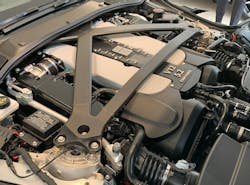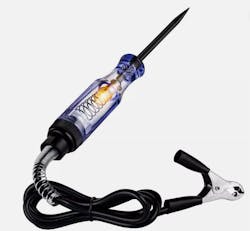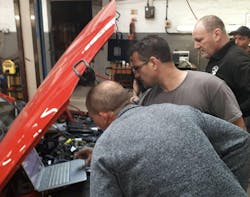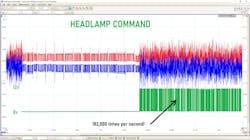How to adapt and implement new diagnostic testing strategies
Key Highlights: Technicians Need to Know
- Traditional tests like compression gauges are becoming less practical due to limited accessibility and evolving engine designs.
- Advanced tools such as lab scopes and communication network analysis provide deeper insights into electrical and electronic system faults.
- Practicing new diagnostic techniques on known-good vehicles helps build confidence and understanding before applying them to real-world problems.
- Capturing and reviewing pre- and post-repair data enhances fault recognition and confirms diagnosis accuracy.
- Embracing new testing methods reduces unnecessary disassembly, saves time, and prevents costly misdiagnoses.
Like many of you, I began my path towards being a driveability technician learning basic tests that have been around for decades. These tests worked well but the issue I find with these tried-and-true tests is that they are becoming more and more difficult to implement with today’s powertrain configurations.
For example, look under the hood of nearly any vehicle using an internal combustion engine and simply imagine removing the spark plugs to perform a compression test. You’d be hard-pressed to complete that task easily, or in an efficient manner (Figure 1). Component accessibility is not as it used to be and with that, if you want to stay on the forefront of efficiency, your diagnostic tools and testing strategies must adapt as well. The question becomes, “What are you waiting for?”
Engine Failures Like Never Before
But I know what many of you are thinking. And the answer to the question above is typically derived from two different camps.
- “I don’t need that new stuff; my compression gauge hasn’t let me down in 30 years”
- "I’m not sure how to use those fancy tools. I’m just not good with that sort of stuff.”
Well, I have a valid answer to both because I can speak from experience with each! Let me first state that engines are not nearly as robust as they once were. Sometimes the slightest overheating condition can wreak havoc on an engine. So much so that the entire assembly requires replacement. And the reason makes total sense.
With stringencies of today’s emissions standards on the rise, manufacturers have been forced to drastically increase fuel economy and engine performance output, but at the same time must reduce tailpipe emissions. (This includes carbon dioxide production, typically viewed as an indicator gas for efficiency, a desirable gas, it’s now viewed as a greenhouse gas that contributes to global warming.)
The real kicker is all of this must be derived from smaller power plants. This is the reason we’ve seen many vehicles typically equipped with 8-cylinder platforms drop two of the cylinders.
With all the performance technologies combined this is possible but it requires the engines to be pushed to the brink of destruction. Manufacturers extract every bit of power output from them as possible. At the same time, these engines have become very sensitive, and as a result I have seen more engine-mechanical failures in the last five years than I have in the previous 23 years combined!
So why did I get away from traditional testing, like the mechanical gauge compression test? For one, as mentioned above, accessibility is becoming more of a premium. But more to the point, the compression test only shows a cylinder’s ability to harness and squeeze what’s inside it.
I mention this point because most of the engine failures I see today are with the valvetrain. A simple collapsed intake valve lifter or one that was wiped out with a disintegrating cam lobe drastically reduces valve duration and directly affects the cylinder charge (Figure 2). Even with a perfectly sealed cylinder, compression could be far below specification. The traditional compression test will show you “low-compression” but won’t tell you why. To know more requires disassembly and inspection. Many times, this is an expensive gamble, especially on today’s powertrains.
Advanced Electrical/Electronic Systems
Electricity has been present in automobiles since their inception. For decades, technicians relied on simple devices like test lights and digital volt/ohm meters (DVOMs) to prove out circuit integrity. And, although both of these devices function well, they indeed have limitations (Figure 3).
In years past, the electronics were limited compared to what is found in today’s vehicles. Simple circuits that carried a lot of current (like power window switches) were designed to be in series with the motor itself. This means the entire circuit saw the same current flow as the motor windings. Basic tools like test lights were all that we needed to determine circuit integrity as almost any change would yield a different brilliance (or none, at all) from the test light, making faults easy to detect.
However, these simple circuits have been replaced with electronic control. Of course, there is still a requirement for the high current flow, but it’s limited to the motor circuit itself — not the switched circuits providing the window request. These switched inputs may be messages from a communication network. These circuits carry minimal current (certainly not enough to illuminate a test light). And it’s the width of the pulses (in different combinations) that determines the message being delivered. Not even a voltmeter could demonstrate that well. Diagnosis is limited to the robustness of the scan tool software, the technician’s understanding of the communication network protocol and most often, a thorough process of elimination, dedicating a lot of time to disassembly.
Pushing Your Boundaries
Above were just a few examples to make my point. Of course, there are many more. But to demonstrate an approach to help you step outside of your comfort zone, I would like you to imagine yourself in my shoes. I do not want you to do drop your routine like a bad habit. If you are an experienced diagnostician and you are seeing success and accuracy in your diagnoses, wonderful! Keep doing it!
To broaden your horizons, you are going to have to reach farther than you have before. This can be an almost painless process if you set yourself up for success. My goal for you is to be confident in your venture, and to do so means to have a plan.
Step #1: Begin implementing the tests you are learning on known-good vehicles. My recommendation is to schedule some time each week to stay late after work. Prove to yourself that you can set up and capture the correct data for whichever new test/tool you are implementing. Of course, the data should reflect a healthy functioning component or system (Figure 4).
I make this suggestion because otherwise, when you have hiccups — of course, there will be hiccups along the way but that is part of the learning process — you’ll surely struggle to distinguish between a true fault of the vehicle and an oversight in the testing process being implemented. If you can do that, you are ready to take the next step.
Step #2: Now it’s time to approach a broken vehicle. What I am requesting you do is add some more work for yourself. Yes, that’s right, do the “new test” (in this case, the relative compression test). But what I’d like for you to do is simply capture the relative compression data as best as you can. Save the scope data captured and do not rely on it as input for diagnosis. Continue to rely on the mechanical gauge compression test because you trust it and it has served you well. When you have a diagnosis present it to your customer (however that occurs in your shop) and assuming the approval for repair is offered, complete the job.
Step #3: Now, when the repair is complete, and before delivering the vehicle to the customer, repeat the relative compression test and again, save the scope data. When the dust settles and the workday is over, take the time to review the pre- and post-repair files for analysis. When success occurs, you will know it because you will recognize the fault in the capture, and it will correlate directly with the tried-and-true mechanical gauge compression testing you have carried out.
Practice Makes Perfect
Let’s try another example. Go back to an intermittent “no-communication” issue, perhaps it's due to a fault that won’t allow communication on the network. Nowadays, the scan tool software (at least at the OE level) is robust enough to offer some excellent preliminary data to support communication network fault diagnosis. However, even the greatest software won’t come out and point to the faulty component.
With that, the name of the game is “divide and conquer.” In the case of the fault described above, a fault in the wire harness could cause the symptom. Although a process of elimination could eventually render a diagnosis, the potential dozens of nodes on the network (strewn throughout the vehicle) could also be the cause.
Then again, an output that is controlled by the suspect-ECU could create electrical noise (creating feedback to that ECU) contaminating the entire network. This would make the node look faulty and would lead to unnecessary replacement. The outcome would be very disappointing and potentially expensive. I urge you again to do what you do. Follow the same steps as in the previous example. Before the vehicle is repaired, take the time to implement a new test.
Perhaps you recently attended some training, learning to implement a lab scope to view CAN bus network activity. Take this time to monitor the network, before a repair attempt is made. Reproduce the fault and capture the CAN bus network activity with the lab scope.
Viewing the data and (for example) seeing that CAN_Hi and CAN_Low both exhibited some high-frequency noise, but only when the headlamps were on was cause for concern but also led to a visual inspection.
The headlamp bulbs were LED but should’ve been HID. Using this data pointed the technician toward a wiring diagram that showed the body control module (BCM) as the device driving the headlamp circuits.
The transistors operated at a very high frequency because the BCM was not happy with the unexpectedly low current values of the headlamp circuits. This high-frequency switching induced noise on the network (Figure 5).
What’s the point? If not for the lab scope, the noise wouldn’t have been seen. The technician would likely have condemned the BCM for being faulty and would’ve replaced it unnecessarily.
What’s more important is there was no need for disassembly, nor process of elimination. The data derived from the scope capture yielded no reason to condemn anything but the aftermarket headlamp bulbs. This never could have been determined with certainty without the scope testing. In fact, it’s unlikely that any tech would’ve found this root cause fault in any reasonable amount of time, or without many misdiagnoses along the way.
The Leap of Faith
I can promise you several things if you heed my advice. For one, you will feel a sense of frustration as these new and unfamiliar tests will leave you with many failed attempts. But Thomas Edison failed to make the light bulb properly 10,000 times before seeing success. Stick with it!
Secondly, there is a time and place for everything. Please don’t get yourselves into trouble by trying to “learn on the job.” Each one of our work bays is a business within a business. They must be profitable, and this can't occur if we experiment on the clock. Schedule some time after hours (I suggest once per week) to experiment with known-good vehicles.
And last, but certainly not least, learn to trust your test results like a pilot of a jet airliner trusts his or her gauges in the clouds. When you practice enough, a sense of confidence builds within you. You’ll certainly find that knowledge begets new knowledge and testing in the described fashion will make you a better, more knowledgeable technician, making you a very powerful diagnostic weapon.
In seemingly no time at all, you will put to rest the time-consuming tests you’ve relied on so heavily for so long. You will begin to replace those tests with the newer, more efficient and less invasive testing you’ve been practicing diligently to implement.
Just like learning to ride a bicycle with the training wheels on, it’s a process. But one worth seeing through as it will serve you well for the remainder of your career. Make tomorrow a new day and take your career as a diagnostician in a very rewarding direction. Learning with the training wheels on is safe and gratifying — you’ll see.
About the Author
Brandon Steckler
Technical Editor | Motor Age
Brandon began his career in Northampton County Community College in Bethlehem, Pennsylvania, where he was a student of GM’s Automotive Service Educational program. In 2001, he graduated top of his class and earned the GM Leadership award for his efforts. He later began working as a technician at a Saturn dealership in Reading, Pennsylvania, where he quickly attained Master Technician status. He later transitioned to working with Hondas, where he aggressively worked to attain another Master Technician status.
Always having a passion for a full understanding of system/component functionality, he rapidly earned a reputation for deciphering strange failures at an efficient pace and became known as an information specialist among the staff and peers at the dealership. In search of new challenges, he transitioned away from the dealership and to the independent world, where he specialized in diagnostics and driveability.
Today, he is an instructor with both Carquest Technical Institute and Worldpac Training Institute. Along with beta testing for Automotive Test Solutions, he develops curriculum/submits case studies for educational purposes. Through Steckler Automotive Technical Services, LLC., Brandon also provides telephone and live technical support, as well as private training, for technicians all across the world.
Brandon holds ASE certifications A1-A9 as well as C1 (Service Consultant). He is certified as an Advanced Level Specialist in L1 (Advanced Engine Performance), L2 (Advanced Diesel Engine Performance), L3 (Hybrid/EV Specialist), L4 (ADAS) and xEV-Level 2 (Technician electrical safety).
He contributes weekly to Facebook automotive chat groups, has authored several books and classes, and truly enjoys traveling across the globe to help other technicians attain a level of understanding that will serve them well throughout their careers.





